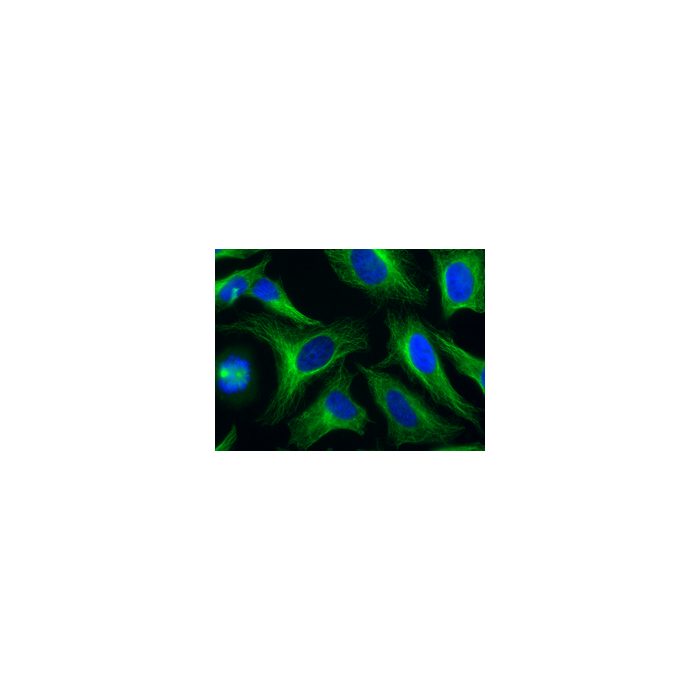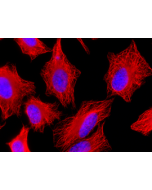Cookie Policy: This site uses cookies to improve your experience. You can find out more about our use of cookies in our Privacy Policy. By continuing to browse this site you agree to our use of cookies.
AdipoGen Life Sciences
anti-α-Tubulin, mAb (rec.) (F2C) (ATTO 488)
As low as
390
CHF
CHF 390.00
In stock
Only %1 left
AG-27B-0005TD-C100100 µgCHF 390.00

Figure 1: Human alpha-Tubulin is detected by immunocytochemistry using anti-alpha-Tubulin, mAb (rec.) (F2C) (ATTO 488) (Prod. No. AG-27B-0005TD).
Method: HeLa cells are grown in standard culture conditions, fixed with methanol, and incubated with anti-alphaTubulin, mAb (rec.) (F2C) (ATTO 488) (1µg /ml in PBS-BSA). After incubation for 30 min at RT and several washes in PBS, cells are treated with a goat anti-human (Cy3) antibody for 30 min at RT, washed and mounted in Moewiol. Nuclei are stained with DAPI.
Picture courtesy of Dr. Moutel, Dr. Franck Perez Lab, Curie Institute, Paris.
Method: HeLa cells are grown in standard culture conditions, fixed with methanol, and incubated with anti-alphaTubulin, mAb (rec.) (F2C) (ATTO 488) (1µg /ml in PBS-BSA). After incubation for 30 min at RT and several washes in PBS, cells are treated with a goat anti-human (Cy3) antibody for 30 min at RT, washed and mounted in Moewiol. Nuclei are stained with DAPI.
Picture courtesy of Dr. Moutel, Dr. Franck Perez Lab, Curie Institute, Paris.
Figure 2: Structure of the recombinant antibody anti-alpha-Tubulin, mAb (rec.) (F2C) (Prod. No. AG-27B-0005). The single chain variable human fragment (ScFv) selected by antibody phage display technology and specific to the antigen of interest is fused to a human IgG2 Fc region.
| Product Details | |
|---|---|
| Product Type | Recombinant Antibody |
| Properties | |
| Clone | F2C |
| Isotype | Human IgG2λ |
| Source/Host | Produced without the use of animals. Purified from HEK 293 cell culture supernatant. |
| Immunogen/Antigen | Bovine brain tubulin. |
| Label/Conjugates | ATTO 488 |
| Application |
Immunocytochemistry: (1:1'000) |
| Crossreactivity |
Bovine Human Mouse |
| Specificity |
Recognizes mouse, bovine and human α-tubulin. |
| Purity | ≥95% (SDS-PAGE) |
| Purity Detail | Protein A-affinity purified. |
| Concentration | Lot-dependent |
| Formulation | Liquid. In PBS containing 0.02% sodium azide. |
| Isotype Negative Control | |
| Other Product Data |
anti-α-Tubulin, monoclonal antibody (recombinant) (F2C) (ATTO488) is composed of human variable regions (VH and VL) (λ-chain) of immunoglobulin fused to the human lgG2 Fc domain. anti-α-Tubulin, monoclonal antibody (recombinant) (F2C) (ATTO488) is an antibody developed by antibody phage display technology using a human naive antibody gene library. These libraries consist of scFv (single chain fragment variable) composed of VH (variable domain of the human immunoglobulin heavy chain) and VL (variable domain of the human immunoglobulin light chain) connected by a polypeptide linker. The antibody fragments are displayed on the surface of filamentous bacteriophage (M13). This scFv was selected by affinity selection on antigen in a process termed panning. Multiple rounds of panning are performed to enrich for antigen-specific scFv-phage. Monoclonal antibodies are subsequently identified by screening after each round of selection. The selected monoclonal scFv is cloned into an appropriate vector containing a Fc portion of interest and then produced in mammalian cells to generate an IgG like scFv-Fc fusion protein. |
| Shipping and Handling | |
| Shipping | BLUE ICE |
| Short Term Storage | +4°C |
| Long Term Storage | +4°C |
| Use/Stability |
Keep conjugated formats at +4°C. Stable for at least 1 year after receipt when stored at +4°C. |
| Documents | |
| Protocols |
 Download PDF Download PDF |
| MSDS |
 Download PDF Download PDF |
| Product Specification Sheet | |
| Datasheet |
 Download PDF Download PDF |
Description
Tubulin is the major building block of microtubules. This intracellular cylindrical filamentous structure is present in almost all eukaryotic cells. Microtubules function as structural and mobile elements in mitosis, intracellular transport, flagellar movement, and the cytoskeleton.
Product References
- Recombinant antibodies selected against subcellular fractions to track endogenous protein dynamics in vivo: C. Nizak, et al.; Traffic 7, 739 (2003)
- Characterization of single chain antibody targets through yeast two hybrid: O. Vielemeyer, et al; BMC Biotechnol. 10, 59 (2010)
- AIM2 inflammasome is activated by pharmacological disruption of nuclear envelope integrity: A. Di Micco, et al.; PNAS 113, e4671 (2016)
- Pharmacological eEF2K activation promotes cell death and inhibits cancer progression: A. De Gassart, et al.; EMBO Reports 17, 1471 (2016)
- Tumor-induced reshuffling of lipid composition on the endoplasmic reticulum membrane sustains macrophage survival and pro-tumorigenic activity: G. Di Conza, et al.; Nat. Immunol. 22, 1403 (2021)
- The protease DDI2 regulates NRF1 activation in response to cadmium toxicity: S.T. Ribeiro, et al.; iScience 25, 105227 (2022)
- CDC42 regulates PYRIN inflammasome assembly: L. Spel, et al.; Cell Rep. 41, 111636 (2022)
- NLRP3 leucine-rich repeats control induced and spontaneous inflammasome activation in cryopyrin-associated periodic syndrome: K. Theodoropoulou, et al.; J. Allergy Clin. Immunol. 151, 222 (2023)
- HSP90beta controls NLRP3 autoactivation: L. Spel, et al.; Sci. Adv. 10, eadj6289 (2024)
- The integrin CD11b inhibits MSU-induced NLRP3 inflammasome activation in macrophages and protects mice against MSU-induced joint inflammation: D. Ehirchiou, et al.; Arthritis Res. Ther. 26, 119 (2024)
- Protofilament-specific nanopatterns of tubulin post-translational modifications regulate the mechanics of ciliary beating: G. Alvarez Viar, et al.; Curr. Biol. 34, 4464 (2024)








